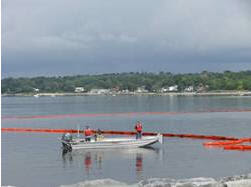 It may look like an oil spill response on Padilla Bay Thursday morning. But it’s only a drill.
It may look like an oil spill response on Padilla Bay Thursday morning. But it’s only a drill.Spill response boats, oil skimmers and other equipment will take to southern part of the bay in Skagit County for what’s called a combined deployment drill. Everything needed for the real thing will be there, except the oil, which is not used in a practice like this.
The Washington Department of Ecology will observe and evaluate the exercise.
Spills Preparedness
Staging an exercise in Padilla Bay will allow spill responders to focus on the special requirements of operating in shallow water. The bay empties completely at low tide to expose miles of mud flats and eelgrass beds. At high tide much of the bay is less than 10 feet deep.This means the boats have only the peak two hours of the high tide in which to work, navigate without grounding and retreat to deeper water. Thursday’s high tide is predicted for 12:12 p.m. at 7.1 feet.
The private, not-for-profit Marine Spill Response Corporation (MSRC) will conduct the exercise, using four skimmers and several additional boats. MSRC will be joined by its British Columbia counterpart, Burrard Clean Operations (BCO). About two dozen people from the two organizations will participate.
MSRC will deploy vessels in oil-skimming formations on open water, and will dispatch crews to the mouth of Telegraph Slough on the bay’s southern shore to deploy 2,000 feet of boom a floating, segmented barrier to keep oil from entering that waterway.

Oil-skimming V formation: Boom drawn by the leading work boats channels oil to the skimmer at the v-point.
- Skimming. The most common method is the V formation. The skimmer is at the point, aimed toward the inside, working with two other vessels. Several yards of boom connect the skimmer with each helper boat.
As the three-boat formation moves forward, oil is funneled by the V toward the skimmer. Usually a helicopter guides the skimming, but we won’t have a chopper on Thursday. The crews will practice working in formation and keeping the V in trim. - Booming off the slough. There are dozens of places around Puget Sound that will be protected first if there’s an oil spill nearby. The overall plan is called the Geographical Response Plan, or GRP. Each site is called a GRP, and the entrance to Telegraph Slough is actually two of these, one on each side of mouth.
Crews in work boats will follow plans already written for this location to anchor and position the bright yellow or orange boom to protect the slough.
Drill Sponsors

Boom deployment: A work boat tows boom into place at a Geographical Response Plan site.
Eleven of these companies are sponsoring the drill:
- Sea River Maritime, Inc.
- Polar Tankers, Inc.
- BP Shipping
- BP Cherry Point Refinery
- Kinder Morgan Transmoutain Pipeline
- Alaska Tanker Company
- Tesoro Anacortes Refinery
- ConocoPhillips Ferndale Refinery
- Harley Marine Services, Inc.
- Shell Puget Sound Refinery
- Olympic Pipe Line Co.
By doing so, they will fulfill a part of the Washington State oil-spill preparedness requirements that apply to them. Larger ships and facilities must develop, update and practice oil spill contingency plans. These plans are separate and in addition to spill-prevention plans and programs they must develop and follow.
The Padilla Bay drill is part of Ecology’s work on spill preparedness. Ensuring this preparedness forms part of Ecology’s overall effort to reduce toxic threats to public safety, health and the environment and to support the statewide initiative to protect and restore Puget Sound.
Padilla Bay between Anacortes and Mount Vernon is a National Estuarine Research Reserve, administered by Ecology, with its headquarters and education center near Bay View.
Also see our news release, Spill response practice set for Padilla Bay (March 23, 2010)

No comments:
Post a Comment